Abraliopsis atlantica
Kotaro TsuchiyaIntroduction
A. atlantica was based primarily on the illustrations of an enoploteuthid squid in Chun (1910). While the specimen illustrated (mature male, 20 mm ML) has been located and designated as the lectotype, No adequate description has been published in spite of the relatively common occurrence of this squid. We have seen several damaged squid. It appears to be very similar to Abraliopsis sp. A.
Characteristics
- Tentacle clubs
- Ventral hooks about 3 times height of dorsal counterparts.
- Club with short keel limited to dactylus; carpal flap absent.
 Click on an image to view larger version & data in a new window
Click on an image to view larger version & data in a new window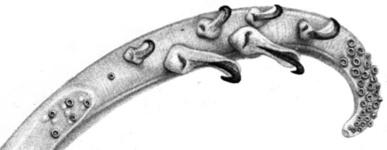
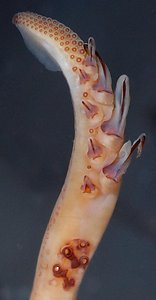
Figure. Oral view of the tentacular club of A. atlantica. Left - mature male, eastern tropical Atlantic. Drawing from Chun (1910, Plate VIII, Fig. 5). Right - Western tropical Atlantic, showing small but distinct club and large differences in sizes of dorsal and ventral hooks. Photograph by R. Young.
- Arms
- Arms IV relatively long.
- Arms IV relatively long.
- Hectocotylus and male sexual dimorphism
- Hectocotylus with two subequal-sized offset flaps.
- Modified portion without armature.
- Protective membrane and its spatulate trabeculae well developed on left arm IV, web-like; minute conical papillae on trabeculae.
- Integumental Photophores
- Ventral mantle with six narrow longitudinal stripes of large integumental organs and scattered intermediate small organs between stripes and with a distinct wide mid-ventral photophore-less strip.
- Ventral head with three narrow, longitudinal stripes and some intermediate scattered organs between them.
- Stripes of organs along ventral side of arm III and dorsal side of arm IV are interrupted.
Comments
This species closely resembles Abraliopsis sp. A and present information is insufficient to distinguish it. Its Identification rests on its location in the Atlantic Ocean.Nomenclature
Chun (1910) redescribed Abraliopsis morisii (Vérany, 1839) from Atlantic and Indian Ocean specimens. The illustrations accompanying the text clearly show that more than one species was included in the description. Subsequently, Nesis (1982) named, primarily on the basis of these illustrations, two new species of Abraliopsis (i.e., A. atlantica and A. chuni). More recently, the squids that were illustrated were located and designated as lectotypes of their respective species (Glaubrecht. and Salcedo-Vargas, 2000).Life history
Age
Longetivity is up to 5 months in females and 3.5months in males (Arkhipkin and Murzov, 1990).Distribution
Vertical Distribution
In the Benguela area, equatorial East Atlantic, this species is distributed vertically in the upper layer of the thermocline during daytime, and from the surface to 100-150m at night (Arkhipkin and Murzov, 1990).
Geographical Distribution
Tropical to subtropical Atlantic, Caribbean Sea, and the Gulf of Mexico (Nesis, 1982/87).
References
Arkhipkin, A.I. and Murzov, S.A. 1990. Age and growth pattern of the micronectonic squid Abraliopsis atlantica. Biologiya Morya, no.5, 19-25.
Glaubrecht, M. and M.A. Salcedo-Vargas. 2000. Annotated type catalogue of the Cephalopoda (Mollusca) in the Museum für Naturkunde, Humboldt University of Berlin. Mitteilungen aus dem Museum für Naturkunde Berlin, Zoologischen, 76(2):269-282.
Chun, C. 1910. Die Cephalopoden. Oegopsida. Wissenschaftliche eregebnisse der deutschen tiefsee expedition auf dem dampfer "Valdivia" 1898-1899, 18(1):1-401.
Nesis, K. N. 1982. Abridged key to the cephalopod mollusks of the world's ocean. 385+ii pp. Light and Food Industry Publishing House, Moscow. (In Russian.). Translated into English by B. S. Levitov, ed. by L. A. Burgess (1987), Cephalopods of the world. T. F. H. Publications, Neptune City, NJ, 351pp.
Title Illustrations

| Scientific Name | Abraliopsis atlantica |
|---|---|
| Location | Equatoral Eastern Atlantic at 0°51'N, 0°31'E |
| Reference | Chun, C. 1910. Die Cephalopoden. Oegopsida. Wissenschaftliche eregebnisse der deutschen tiefsee expedition auf dem dampfer "Valdivia" 1898-1899, 18(1):1-401 (Plate VI, fig. 1). |
| Sex | Male |
| View | Ventral |
| Size | 20 mm ML |
| Scientific Name | Abraliopsis atlantica |
|---|---|
| Location | Equatoral Eastern Atlantic at 0°51'N, 0°31'E |
| Specimen Condition | Preserved |
| Identified By | K. Nesis |
| Sex | Male |
| Life Cycle Stage | Mature |
| View | Ventral |
| Size | 20 mm ML |
| Collection | Museum für Naturkunde, Humboldt University of Berlin |
| Type | Lectotype |
| Collector | R/V VALDIVIA |
| Image Use |
 This media file is licensed under the Creative Commons Attribution License - Version 3.0. This media file is licensed under the Creative Commons Attribution License - Version 3.0.
|
| Copyright |
©

|
About This Page

Tokyo University of Fisheries, Tokyo, Japan
Page copyright © 2014
All Rights Reserved.
- Content changed 21 January 2014
Citing this page:
Tsuchiya, Kotaro. 2014. Abraliopsis atlantica . Version 21 January 2014 (under construction). http://tolweb.org/Abraliopsis_atlantica/19683/2014.01.21 in The Tree of Life Web Project, http://tolweb.org/




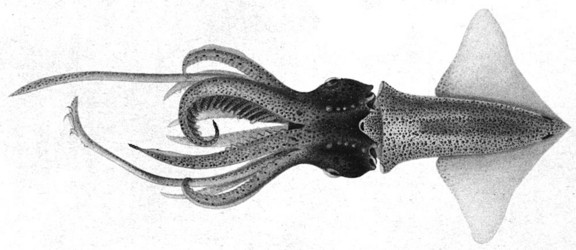
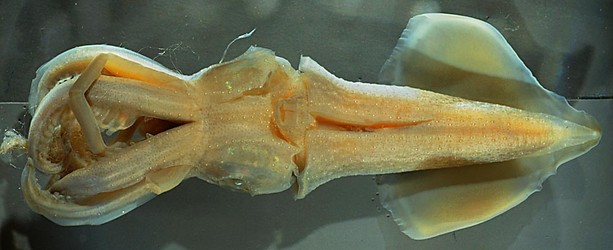
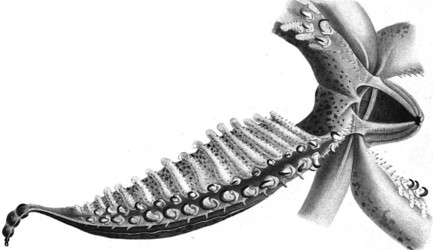
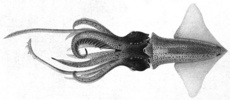
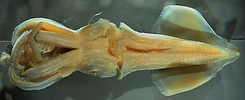


 Go to quick links
Go to quick search
Go to navigation for this section of the ToL site
Go to detailed links for the ToL site
Go to quick links
Go to quick search
Go to navigation for this section of the ToL site
Go to detailed links for the ToL site